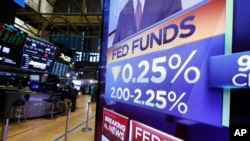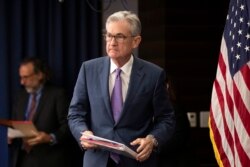When U.S. economists and stock market analysts ponder whether an economically debilitating recession is on the horizon, they often look to an arcane piece of data: whether a yield curve inversion of interest rates on government bonds is occurring. It's called an inverted yield curve.
Specifically, they look at the interest rates for two- and 10-year U.S. Treasury notes.
Typically, interest rates on longer-term government bonds are higher than those for shorter periods of time.
But when that interest rate phenomenon is reversed, as occurred Wednesday, it can be a sign that investors have worries about the immediate state of the U.S. economy, the world's largest, and are demanding a higher rate of return on the shorter-term notes.
The yield on a 10-year Treasury note briefly hit 1.622%, dropping below the 1.634% yield for a two-year bond, although the longer-term yields moved higher in later trading compared to that for the two-year notes, and remained higher in early Thursday trading.
Despite Wednesday's yield curve inversion, former Federal Reserve chair Janet Yellen said she does not think the U.S. is headed to a recession.
“I think the U.S. economy has enough strength to avoid that," she said. "But the odds have clearly risen, and they are higher than I’m frankly comfortable with.”
Yellen said the yield curve inversion has historically "been a pretty good signal of recession, and I think that’s why the markets pay attention to it. But I would really urge on this occasion it may be a less good signal. And the reason for that is that there are a number of factors other than market expectations about the future path of interest rates that are pushing down long-term yields.”
She said, "Uncertainty about trade is having a marked impact on business confidence. It had some direct effects that have been negative on the global economy and on the U.S.”
President Donald Trump, as he often has in recent months, blamed independent policymakers at the Federal Reserve for not boosting the U.S. economy by cutting interest rates faster, beyond the quarter of a percentage point the Fed trimmed its benchmark rate last month.
He called Federal Reverse Chair Jerome Powell "clueless," voicing frustration, in all caps on Twitter, at the "CRAZY INVERTED YIELD CURVE!"
"We should easily be reaping big Rewards & Gains," Trump tweeted, "but the Fed is holding us back. We will Win!"
Wednesday's interest rate inversion was the first since 2007, at the start of the U.S. recession that was the country's worst economic downturn since the Great Depression of the 1930s. Millions of U.S. workers lost their jobs in the recession a decade ago, as well as their homes, when they no longer had enough money to make monthly loan payments.
The bond interest rate inversion has preceded the last nine U.S. recessions over the last six decades, although the barometer is not a perfect indicator. No recession occurred in 1966, even though there had been an inversion.
Moreover, recessions do not usually immediately follow yield curve inversions, often lagging by months, even a year or more. Recessions are defined as at least two consecutive three-month periods of shrinking economic growth.
The Federal Reserve Board in San Francisco said last year, "Forecasting future economic developments is a tricky business, but the (yield curve) has a strikingly accurate record for forecasting recessions. Periods with an inverted yield curve are reliably followed by economic slowdowns and almost always by a recession."
The U.S. economy, while still strong with a low unemployment rate and thousands of jobs being added each month, has nonetheless been trending down.
The U.S. economy grew at an annual rate of 2.1% in the April-to-June period, declining a percentage point from the January-to-March period.
While U.S. stock markets plummeted Wednesday with news of the yield curve inversion, markets moved slightly higher Thursday at the open of the trading day in New York.






